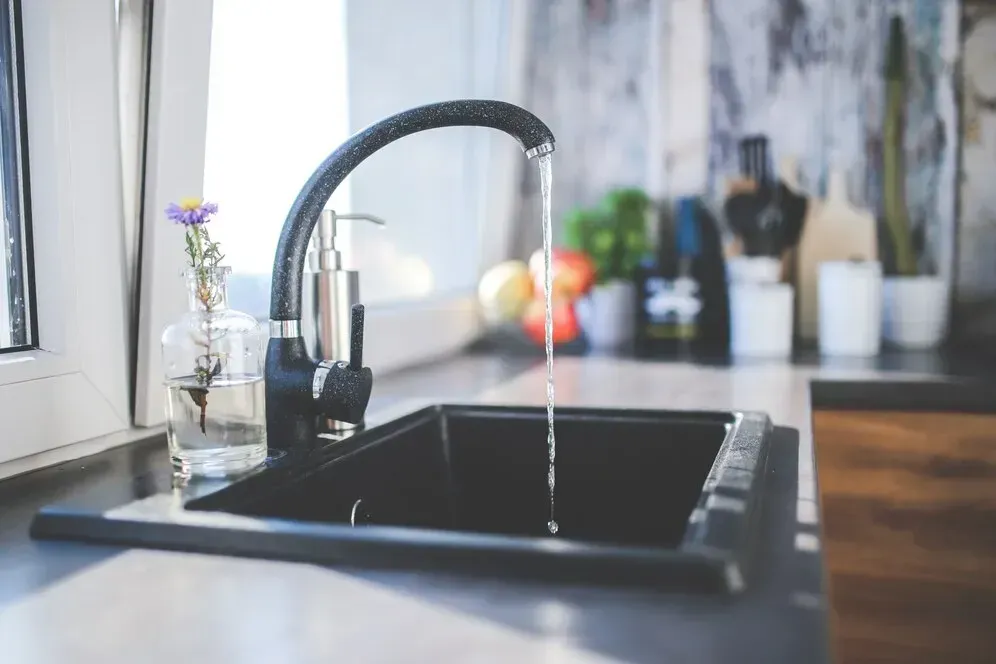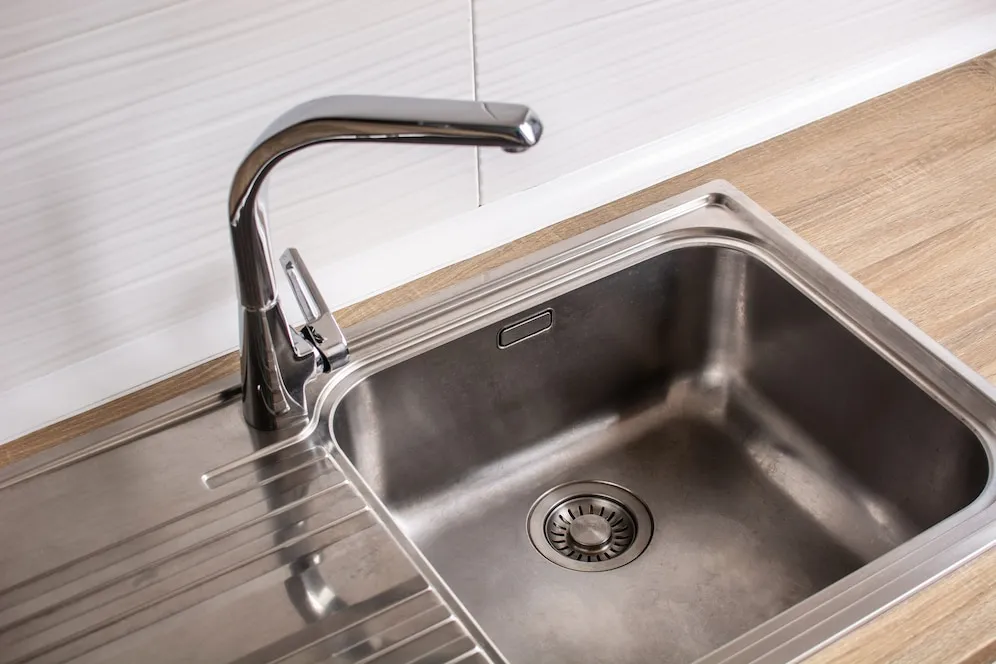Blog

How to Fix a Leaky Kitchen Faucet in Stafford, VA

How to Fix a Leaky Kitchen Faucet
A dripping kitchen faucet isn’t just annoying—it wastes water and raises your utility bill. Even a slow drip can add up to over 3,000 gallons of wasted water per year, increasing your costs and causing potential water damage over time.
The most common cause of a leaky kitchen faucet is a worn-out washer, O-ring, or cartridge. Fixing the problem usually involves turning off the water supply, disassembling the faucet, replacing the damaged part, and reassembling it properly.
This guide walks you through quick DIY fixes, and aims to help you identify when a plumber is necessary.
Why You Should Fix a Leaky Faucet Immediately
Ignoring a leaky kitchen faucet may not seem like a big deal, but the longer it drips, the bigger the problem becomes. A slow leak doesn’t just waste water—it can lead to higher bills, plumbing damage, and even mold growth under your sink.
How Much Water (and Money) You’re Wasting
A faucet that drips once per second can waste over 3,000 gallons of water per year—that’s the same as running your dishwasher more than 180 times. That extra water use can increase your utility bill by hundreds of dollars annually.
Small Leaks Can Lead to Bigger Plumbing Problems
What starts as a small, steady drip can turn into a bigger plumbing issue if left unchecked. Constant water exposure can:
Damage your sink and surrounding cabinets
Cause rust and corrosion in your pipes
Create the perfect environment for mold and mildew
Fixing a leaky faucet now can save you money, time, and future headaches.
If you’re unsure how to fix it yourself, C&P Plumbing in Stafford, VA, offers fast and affordable leak repairs to keep your home safe and dry.
Quick DIY Fixes for a Leaky Kitchen Faucet
Before calling a plumber, try these simple fixes. Many leaks happen because of worn-out parts that are easy to replace. Follow these steps to stop the drip and restore your faucet.
Step 1 – Turn Off the Water Supply
Before you start, shut off the water to avoid a mess.
Look under the sink for the shut-off valves (one for hot water, one for cold).
Turn them clockwise until they’re fully closed.
Open the faucet to release any remaining water.
If your sink doesn’t have shut-off valves, you’ll need to turn off the main water supply to your home.
Step 2 – Disassemble the Faucet & Inspect the Parts
Use a screwdriver to remove the faucet handle.
Depending on your faucet type, you may need to unscrew the packing nut with a wrench.
Carefully remove the washer, O-ring, or cartridge, depending on your faucet’s design.
Check for cracks, corrosion, or worn-out rubber parts.
Step 3 – Replace the Damaged Components
Once you’ve identified the faulty part, take it to a hardware store to find an exact replacement.
Compression Faucets – Replace the rubber washer.
Ball Faucets – Swap out the valve seat and cam assembly.
Cartridge Faucets – Install a new cartridge.
Ceramic Disc Faucets – Replace the ceramic disc seals.
Step 4 – Reassemble and Test for Leaks
Put all parts back in place and tighten everything securely.
Turn the water supply back on and test the faucet.
If it’s still leaking, double-check that all parts are fitted correctly.
A quick fix works in most cases, but if the leak persists or worsens, it may be time to call a professional plumber. C&P Plumbing in Stafford, VA, offers expert kitchen leak detection and repair for tough faucet problems.
When DIY Fixes Won’t Work – Time to Call a Plumber
Not all leaks can be fixed with a simple washer or cartridge replacement. If the problem keeps coming back or gets worse, it’s time to bring in a professional. Ignoring a stubborn leak can lead to bigger plumbing issues, water damage, and higher repair costs.
If the Leak Persists After Repairs
If you've replaced the faulty parts and the faucet is still leaking, the problem may be deeper in the plumbing system. Worn-out valve seats, corroded pipes, or improper installation can all cause ongoing leaks that require professional tools and expertise.
Low Water Pressure or Strange Noises
If your kitchen faucet is leaking and the water pressure has dropped, it could signal a clogged or failing pipe. Strange noises—like banging or whistling—when turning the faucet on or off often point to air pockets or pipe damage. These issues can’t be fixed with DIY methods and need professional attention.
Hidden Leaks Under the Sink
Not all leaks are visible. If you notice:
Water stains or puddles under the sink
A musty smell or signs of mold
An unexplained spike in your water bill
There may be a hidden pipe leak behind the walls or inside the cabinet. C&P Plumbing specializes in leak detection and repair, using advanced tools to locate and fix hidden leaks before they cause major damage.
When to Consider a Faucet Replacement
Sometimes, fixing an old faucet isn’t worth the effort. If your faucet is:
Over 10 years old
Constantly needing repairs
Showing signs of rust or corrosion
It may be more cost-effective to replace it with a modern, water-efficient faucet. A professional plumber can help you choose and install the best replacement for your kitchen.
If your kitchen faucet is still leaking, don’t wait for the problem to get worse. Call C&P Plumbing in Stafford, VA, for fast and reliable leak repair services.
Identifying the Cause of Your Kitchen Faucet Leak
Not all leaks come from the same problem. Understanding what’s causing the issue helps you decide whether a DIY fix will work or if it’s time to call a professional.
Common Signs Your Faucet Needs Repair
A leaking faucet doesn’t always mean water dripping from the spout. Watch for these warning signs that signal a problem:
Dripping after shutting off – Likely caused by a worn-out washer, O-ring, or cartridge.
Water pooling at the base – A loose or cracked seal could be letting water escape.
Noisy handle or inconsistent water flow – Could mean mineral buildup, a loose valve, or air in the pipes.
Understanding Your Faucet Type (If You Need Replacement)
Different faucets have different internal parts, which affects how they leak and how they’re repaired.
Compression Faucets – Use rubber washers that wear out over time.
Ball Faucets – Have a single handle and ball valve that can leak if seals wear down.
Cartridge Faucets – Rely on a movable cartridge, which may need replacement when leaking starts.
Ceramic Disc Faucets – Use ceramic discs that are highly durable but can still develop leaks.
Knowing your faucet type helps determine the best fix. If you're unsure or don’t want to risk further damage, C&P Plumbing in Stafford, VA, can inspect, repair, or replace your faucet quickly.
Conclusion
A leaky kitchen faucet may seem like a small problem, but it can waste thousands of gallons of water and lead to higher utility bills. Whether it’s a worn-out washer, faulty O-ring, or failing cartridge, addressing the issue early can save you from costly water damage and future plumbing repairs. While some leaks can be fixed with simple DIY methods, persistent drips, low water pressure, or hidden leaks often require professional plumbing services.
Tired of that constant drip?
A leaky kitchen faucet does more than just waste water—it increases your bills and could lead to bigger plumbing issues.
Since 1994, C&P Plumbing has provided fast, reliable kitchen leak repairs in Stafford, VA. Whether it’s a simple fix or a full faucet replacement, our expert plumbers are ready to help.
Schedule your service today and stop the leak before it gets worse!
Helpful Links
Services
Contact Information
Mon - Fri: 8:00 AM - 4:30 PM
Sat: 8:00 AM - 11:00 AM
© 2025 All Rights Reserved | C & P Plumbing


